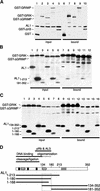A geminivirus replication protein interacts with a protein kinase and a motor protein that display different expression patterns during plant development and infection
- PMID: 12172024
- PMCID: PMC151467
- DOI: 10.1105/tpc.003681
A geminivirus replication protein interacts with a protein kinase and a motor protein that display different expression patterns during plant development and infection
Abstract
The geminivirus protein AL1 initiates viral DNA replication, regulates its own expression, and induces plant gene transcription. To better understand how AL1 interacts with host proteins during these processes, we used yeast two-hybrid library screening and a baculovirus protein interaction system to identify plant proteins that interact with AL1. These studies identified a Ser/Thr kinase, a kinesin, and histone H3 as AL1 partners. The kinase is autophosphorylated and can phosphorylate common kinase substrates in vitro. The kinesin is phosphorylated in insect cells by a cyclin-dependent kinase. Immunostaining of Nicotiana benthamiana and Arabidopsis showed that kinase protein levels and subcellular location are regulated during plant development and geminivirus infection. By contrast, the kinesin is ubiquitous even though it is associated with the spindle apparatus in mitotic cells. Together, our results establish that AL1 interacts with host proteins involved in plant cell division and development. Possible functions of these host factors in healthy and geminivirus-infected plants are discussed.
Figures








Similar articles
-
Geminivirus infection up-regulates the expression of two Arabidopsis protein kinases related to yeast SNF1- and mammalian AMPK-activating kinases.Plant Physiol. 2006 Dec;142(4):1642-55. doi: 10.1104/pp.106.088476. Epub 2006 Oct 13. Plant Physiol. 2006. PMID: 17041027 Free PMC article.
-
Geminivirus pathogenicity protein C4 interacts with Arabidopsis thaliana shaggy-related protein kinase AtSKeta, a component of the brassinosteroid signalling pathway.Virology. 2007 Jun 5;362(2):428-40. doi: 10.1016/j.virol.2006.12.034. Epub 2007 Feb 5. Virology. 2007. PMID: 17280695
-
Geminivirus AL2 and L2 proteins interact with and inactivate SNF1 kinase.Plant Cell. 2003 Apr;15(4):1034-48. doi: 10.1105/tpc.009530. Plant Cell. 2003. PMID: 12671096 Free PMC article.
-
SnRK1: a versatile plant protein kinase that limits geminivirus infection.Curr Opin Virol. 2021 Apr;47:18-24. doi: 10.1016/j.coviro.2020.12.002. Epub 2020 Dec 25. Curr Opin Virol. 2021. PMID: 33360933 Review.
-
Functions of the Arabidopsis kinesin superfamily of microtubule-based motor proteins.Protoplasma. 2012 Oct;249(4):887-99. doi: 10.1007/s00709-011-0343-9. Epub 2011 Oct 25. Protoplasma. 2012. PMID: 22038119 Review.
Cited by
-
The induction of stromule formation by a plant DNA-virus in epidermal leaf tissues suggests a novel intra- and intercellular macromolecular trafficking route.Front Plant Sci. 2012 Dec 27;3:291. doi: 10.3389/fpls.2012.00291. eCollection 2012. Front Plant Sci. 2012. PMID: 23293643 Free PMC article.
-
High-frequency reversion of geminivirus replication protein mutants during infection.J Virol. 2007 Oct;81(20):11005-15. doi: 10.1128/JVI.00925-07. Epub 2007 Aug 1. J Virol. 2007. PMID: 17670823 Free PMC article.
-
A NAC domain protein interacts with tomato leaf curl virus replication accessory protein and enhances viral replication.Plant Cell. 2005 Jan;17(1):311-25. doi: 10.1105/tpc.104.027235. Epub 2004 Dec 17. Plant Cell. 2005. PMID: 15608335 Free PMC article.
-
Functional analysis of a novel motif conserved across geminivirus Rep proteins.J Virol. 2011 Feb;85(3):1182-92. doi: 10.1128/JVI.02143-10. Epub 2010 Nov 17. J Virol. 2011. PMID: 21084480 Free PMC article.
-
SnRK1 phosphorylation of AL2 delays Cabbage leaf curl virus infection in Arabidopsis.J Virol. 2014 Sep;88(18):10598-612. doi: 10.1128/JVI.00761-14. Epub 2014 Jul 2. J Virol. 2014. PMID: 24990996 Free PMC article.
References
-
- Abouzid, A.M., Hiebert, E., and Strandberg, J.O. (1992). Cloning, identification, and partial sequencing of the genomic components of a geminivirus infecting the Brassicaceae. Phytopathology 82, 1070.
-
- Alexiadis, V., Halmer, L., and Gruss, C. (1997). Influence of core histone acetylation on SV40 minichromosome replication in vitro. Chromosoma 105, 324–331. - PubMed
-
- Amundson, S.A., Myers, T.G., and Fornace, A.J. (1998). Roles for p53 in growth arrest and apoptosis: Putting on the brakes after genotoxic stress. Oncogene 17, 3287–3299. - PubMed
-
- Bass, H.W., Nagar, S., Hanley-Bowdoin, L., and Robertson, D. (2000). Chromosome condensation induced by geminivirus infection of mature plant cells. J. Cell Sci. 113, 1149–1160. - PubMed
MeSH terms
Substances
Associated data
- Actions
LinkOut - more resources
Full Text Sources
Other Literature Sources
Molecular Biology Databases

